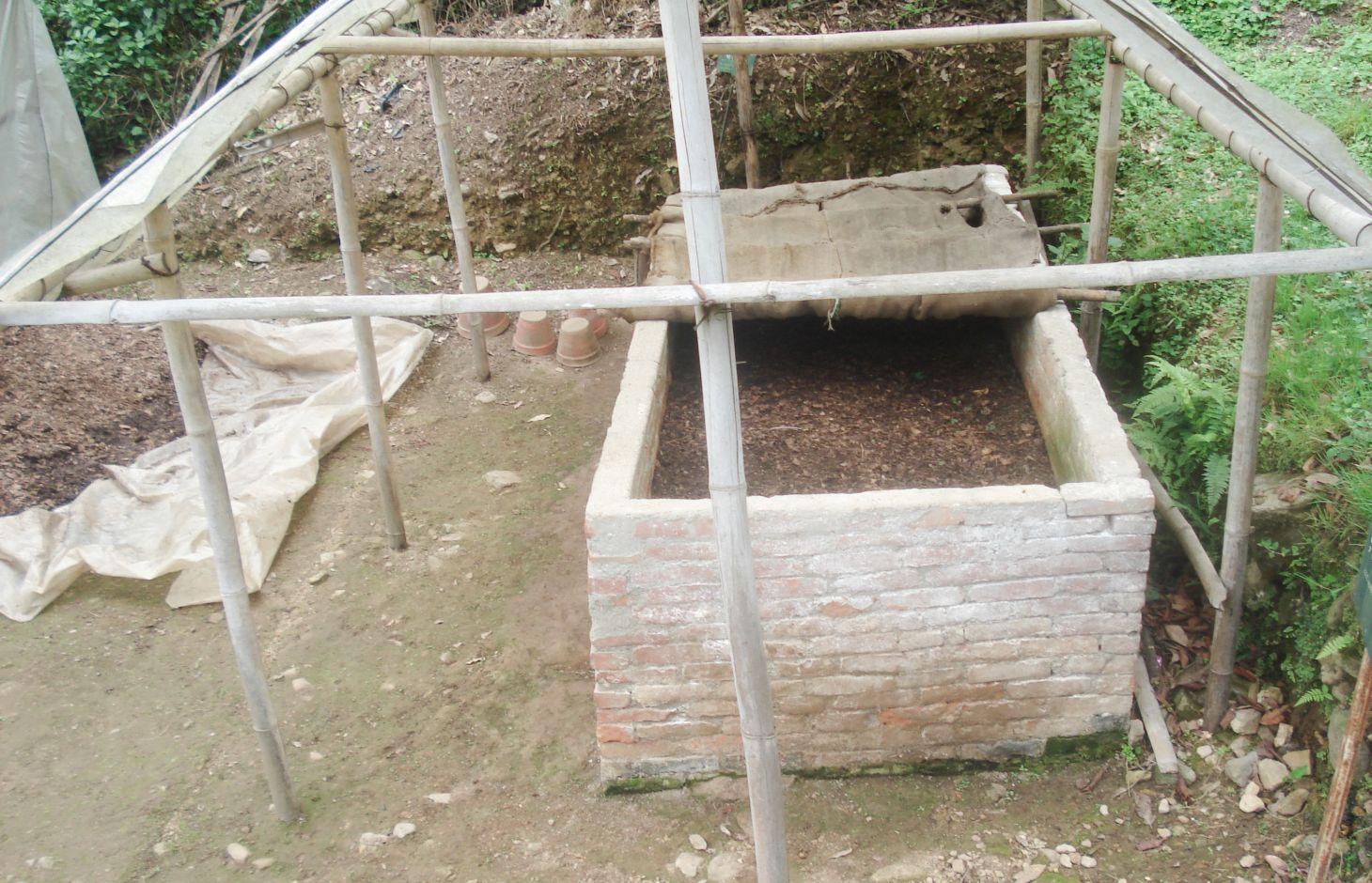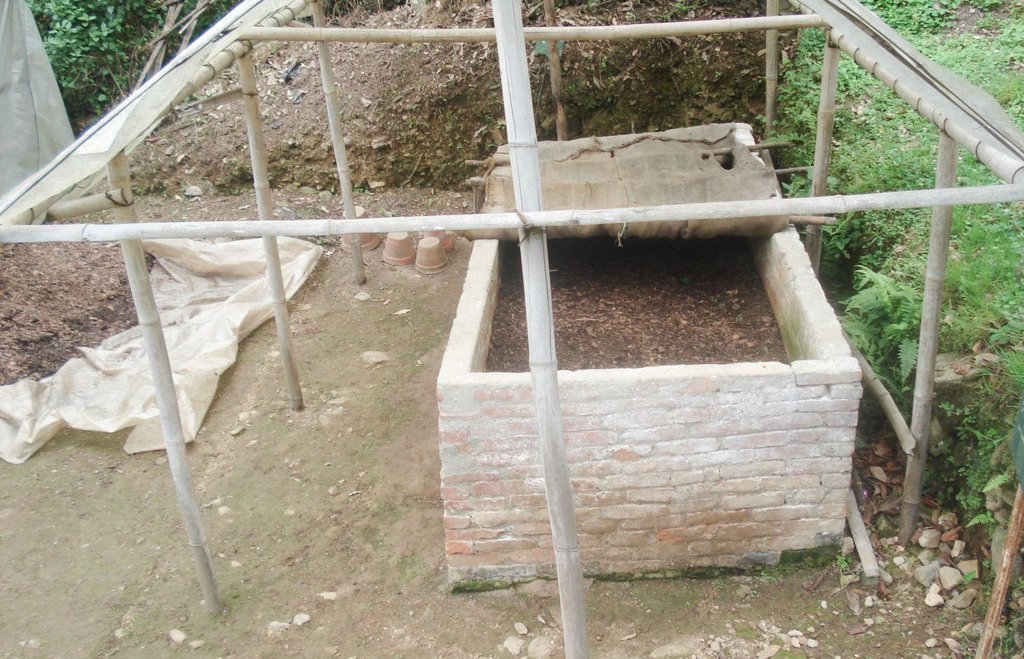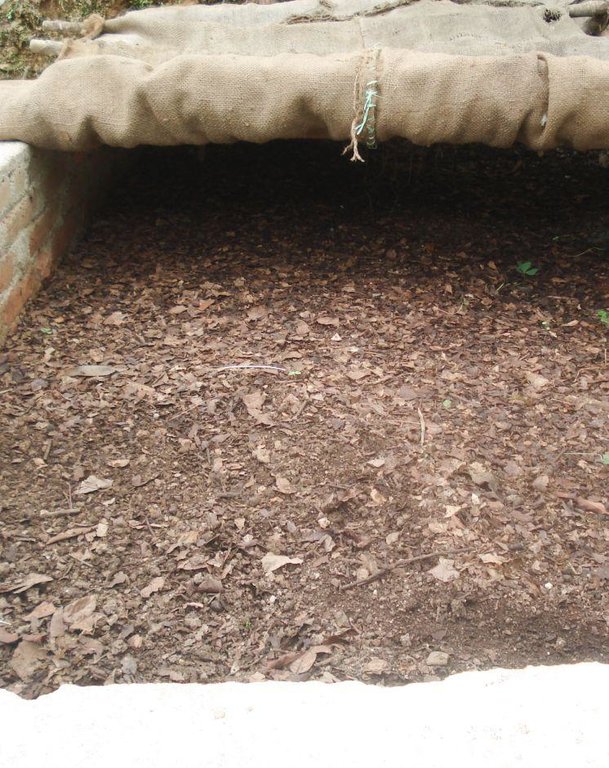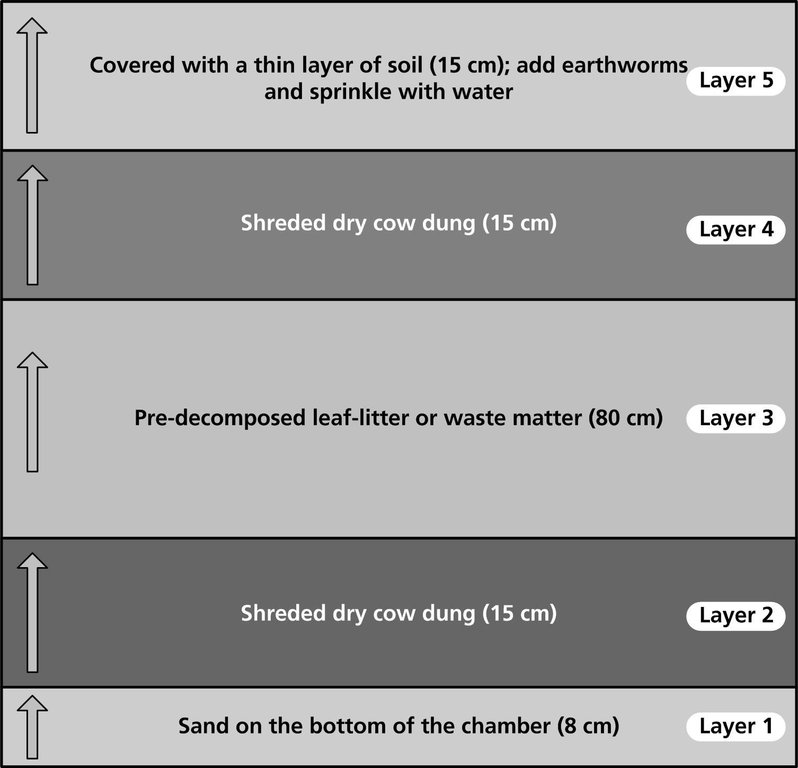Vermicomposting [尼泊尔]
- 创建:
- 更新:
- 编制者: Shreedip Sigdel
- 编辑者: –
- 审查者: David Streiff, Alexandra Gavilano
Gadaula proyog gari mal banaune prabidhi (Main Contributor: Samden Sherpa, ICIMOD)
technologies_1695 - 尼泊尔
查看章节
全部展开 全部收起1. 一般信息
1.2 参与该技术评估和文件编制的资源人员和机构的联系方式
SLM专业人员:
Sherpa Samden Lama
ICIMOD
尼泊尔
有助于对技术进行记录/评估的机构名称(如相关)
ICIMOD International Centre for Integrated Mountain Development (ICIMOD) - 尼泊尔1.3 关于使用通过WOCAT记录的数据的条件
编制者和关键资源人员接受有关使用通过WOCAT记录数据的条件。:
是
2. SLM技术的说明
2.1 技术简介
技术定义:
Vermicomposting or worm composting is a simple technology for converting biodegradable waste into organic manure with the help of earthworms.
2.2 技术的详细说明
说明:
Earthworms are valued by farmers because, in addition to aerating the soil, they digest organic matter and produce castings that are a valuable source of humus. Vermicomposting, or worm composting is a simple technology that takes advantage of this to convert biodegradable waste into organic manure with the help of earthworms (the red worm Eisenia foetida) with no pile turning, no smell, and fast production of compost. The earthworms are bred in a mix of cow dung, soil, and agricultural residues or predecomposed leaf-litter. The whole mass is converted into casts or vermicompost, which can be used as a fertilizer on all types of plants in vegetable beds, landscaping areas, or lawns.
Purpose of the Technology: Worms are so effective at processing organic waste that they can digest almost half their own weight in debris every day. Vermicomposting is a simple composting process that takes advantage of what earthworms do naturally, but confines the worms to bins making it easier for farmers to feed them and to harvest their nutrient-rich compost. Since all worms digest organic matter, in principle, any type of worm can be used; however, not all are equally well adapted to living in bins since some worms prefer to live deep in the soil while others are better adapted to living closer to the surface. The red worm (Eisenia foetida) is ideal for vermicomposting because its natural habitat is close to the surface and it is accustomed to a diet rich in organic matter, this makes it ideally suited to digesting kitchen scraps and to living in bins.
Establishment / maintenance activities and inputs: Vermicomposting can be carried out in different types of containers. There are only a few requirements for a good worm pit, the most important being good ventilation; the pit needs to have more surface area than depth (wide and shallow) and it needs to have relatively low sides. The base of the worm pit is prepared with a layer of sand then alternating layers of shredded dry cow dung and degradable dry biomass and soil are added. Under ideal conditions, 1,000 earthworms can covert 45 kg of wet biomass per week into about 25 kg of vermicompost.
Natural / human environment: Worm castings contain five times more nitrogen, seven times more phosphorous, and eleven times more potassium than ordinary soil, the main minerals needed for plant growth. The vermicompost is so rich in nutrients that it should be mixed 1:4 with soil for plants to be grown in pots and containers. Vermicompost should not be allowed to dry out before using.
Note: This type of vermicomposting is sometimes referred to as 'Pusa' vermicomposting because it was popularized in South Asia by the Rajendra Agricultural University located in Pusa, Bihar, India.
2.3 技术照片
2.5 已应用该技术的、本评估所涵盖的国家/地区/地点
国家:
尼泊尔
有关地点的进一步说明:
Godavari, Lalitpur District
具体说明该技术的分布:
- 适用于特定场所/集中在较小区域
2.7 技术介绍
详细说明该技术是如何引入的:
- 在实验/研究期间
- 通过项目/外部干预
3. SLM技术的分类
3.1 该技术的主要目的
- Improve fertilizer
3.2 应用该技术的当前土地利用类型

农田
- 一年一作
- 多年一作(非木材)

森林/林地
产品和服务:
- 薪材
- 放牧/啃牧
注释:
Major land use problems (compiler’s opinion): Crop productivity is limited by poor soil fertility, intense cropping, and a scarcity of irrigation water. Farmers notice a marked decrease in the health of their crops and degraded soil conditions when chemical fertilizers are overused. Vermicomposting is a low input response to this problem.
Forest products and services: fuelwood
Other forest products and services: fodder
3.5 该技术所属的SLM组
- 土壤肥力综合管理
- 废物管理/废水管理
3.6 包含该技术的可持续土地管理措施

农艺措施
- A2:有机质/土壤肥力
3.7 该技术强调的主要土地退化类型

化学性土壤退化
- Cn:肥力下降和有机质含量下降(非侵蚀所致)
注释:
Main causes of degradation: soil management
3.8 防止、减少或恢复土地退化
具体数量名该技术与土地退化有关的目标:
- 防止土地退化
4. 技术规范、实施活动、投入和成本
4.1 该技术的技术图纸
技术规范(与技术图纸相关):
Establishing a vermicompost pit
Diagram showing the layers needed to set up a vermicompost pit. Note that the middle layer is the thickest; the worms start here and eat both upwards and downwards. It is best to house the pit under a thatched or plastic roof in order to shield it from excessive sunshine and rain.
Technical knowledge required for field staff / advisors: moderate
Technical knowledge required for land users: moderate
Main technical functions: increase in nutrient availability (supply, recycling,…), Improve Soil Fertility
Secondary technical functions: improvement of topsoil structure (compaction), Stabilizes that soil
作者:
AK Thaku
4.2 有关投入和成本计算的一般信息
具体说明成本和投入是如何计算的:
- 每个技术单元
指定单位:
worm pit
指定单位面积(如相关):
A typical outdoor pit can measure 4 m long, 1 m wide and 0.75 m high
具体说明成本计算所用货币:
- 美元
4.3 技术建立活动
| 活动 | 时间(季度) | |
|---|---|---|
| 1. | A low cost pit can be constructed with bricks on a moist or shaded site | |
| 2. | If bricks are not available, stones can be used for the pit construction; | |
| 3. | alternatively, a wooden or bamboo box or a plastic tray can also be used. | |
| 4. | Vermicompost pits are best started during the summer months. | |
| 5. | A thatched roof was built over the pit to help retain moisture in the heap | |
| 6. | at a level of approximately 40–50%, as well as to maintain an optimal temperature of about 20–30oC. | |
| 7. | Sand, soil, cow dung, and leaf litter are piled up as shown in the diagram. | |
| 8. | Material Used are Bricks and cement, dry cow dung, plastic sheet/bamboo, earthworm (around 2000) |
4.4 技术建立所需要的费用和投入
| 对投入进行具体说明 | 单位 | 数量 | 单位成本 | 每项投入的总成本 | 土地使用者承担的成本% | |
|---|---|---|---|---|---|---|
| 劳动力 | Construction of pit | persons/day/unit | 10.0 | 5.0 | 50.0 | |
| 施工材料 | Brick and cement | unit | 1.0 | 70.0 | 70.0 | |
| 施工材料 | Dry cow dung | unit | 1.0 | 10.0 | 10.0 | |
| 施工材料 | Plastic sheet/bamboo | unit | 1.0 | 70.0 | 70.0 | |
| 施工材料 | Earthworm (2000) | unit | 1.0 | 60.0 | 60.0 | |
| 技术建立所需总成本 | 260.0 | |||||
| 技术建立总成本,美元 | 260.0 | |||||
注释:
Duration of establishment phase: 3 month(s)
4.5 维护/经常性活动
| 活动 | 时间/频率 | |
|---|---|---|
| 1. | Water regularly and collect, harvest vermicompost | |
| 2. | The pit is watered regularly. After five to six weeks, the top layer is removed and piled in one corner of the pit. After a few days, the worms will have borrowed down to the bottom of this pile and the compost can be harvested. The compost prepared in the pit should be harvested within 6 months and the pit refurbished as for the first set as discussed above. |
4.6 维护/经常性活动所需要的费用和投入(每年)
| 对投入进行具体说明 | 单位 | 数量 | 单位成本 | 每项投入的总成本 | 土地使用者承担的成本% | |
|---|---|---|---|---|---|---|
| 劳动力 | Watering pit | persons/day/unit | 5.0 | 5.0 | 25.0 | |
| 施工材料 | Dry cow dung | unit | 1.0 | 5.0 | 5.0 | |
| 施工材料 | Water pipe | unit | 1.0 | 10.0 | 10.0 | |
| 技术维护所需总成本 | 40.0 | |||||
| 技术维护总成本,美元 | 40.0 | |||||
4.7 影响成本的最重要因素
描述影响成本的最决定性因素:
All costs and amounts are rough estimates by the technicians and authors. This was a demonstration project conducted by ICIMOD.
5. 自然和人文环境
5.1 气候
年降雨量
- < 250毫米
- 251-500毫米
- 501-750毫米
- 751-1,000毫米
- 1,001-1,500毫米
- 1,501-2,000毫米
- 2,001-3,000毫米
- 3,001-4,000毫米
- > 4,000毫米
农业气候带
- 半湿润
Thermal climate class: temperate
5.2 地形
平均坡度:
- 水平(0-2%)
- 缓降(3-5%)
- 平缓(6-10%)
- 滚坡(11-15%)
- 崎岖(16-30%)
- 陡峭(31-60%)
- 非常陡峭(>60%)
地形:
- 高原/平原
- 山脊
- 山坡
- 山地斜坡
- 麓坡
- 谷底
垂直分布带:
- 0-100 m a.s.l.
- 101-500 m a.s.l.
- 501-1,000 m a.s.l.
- 1,001-1,500 m a.s.l.
- 1,501-2,000 m a.s.l.
- 2,001-2,500 m a.s.l.
- 2,501-3,000 m a.s.l.
- 3,001-4,000 m a.s.l.
- > 4,000 m a.s.l.
5.3 土壤
平均土层深度:
- 非常浅(0-20厘米)
- 浅(21-50厘米)
- 中等深度(51-80厘米)
- 深(81-120厘米)
- 非常深(> 120厘米)
土壤质地(表土):
- 中粒(壤土、粉土)
表土有机质:
- 高(>3%)
如有可能,附上完整的土壤描述或具体说明可用的信息,例如土壤类型、土壤酸碱度、阳离子交换能力、氮、盐度等。:
Soil fertility is medium
Soil drainage / infiltration is medium
Soil water storage capacity is medium
5.4 水资源可用性和质量
地下水位表:
< 5米
地表水的可用性:
好
水质(未处理):
良好饮用水
关于水质和水量的注释和进一步规范:
Water quality (untreated): Also for agricultural use (irrigation)
5.5 生物多样性
物种多样性:
- 高
关于生物多样性的注释和进一步规范:
695 species of flora and 230 species of fauna have been documented within the Park's 30 ha area
5.6 应用该技术的土地使用者的特征
生产系统的市场定位:
- 混合(生计/商业)
非农收入:
- > 收入的50%
相对财富水平:
- 贫瘠
机械化水平:
- 手工作业
- 畜力牵引
说明土地使用者的其他有关特征:
Population density: < 10 persons/km2
5.7 应用该技术的土地使用者使用的平均土地面积
- < 0.5 公顷
- 0.5-1 公顷
- 1-2 公顷
- 2-5公顷
- 5-15公顷
- 15-50公顷
- 50-100公顷
- 100-500公顷
- 500-1,000公顷
- 1,000-10,000公顷
- > 10,000公顷
5.8 土地所有权、土地使用权和水使用权
- Governement
- ICIMOD
- ICIMOD
5.9 进入服务和基础设施的通道
道路和交通:
- 贫瘠
- 适度的
- 好
labour:
- 贫瘠
- 适度的
- 好
6. 影响和结论性说明
6.1 该技术的现场影响
社会经济效应
收入和成本
农业投入费用
工作量
注释/具体说明:
The vermicompost pit needs to be watered and maintained regularly
其它社会经济效应
Earthworms need to be purchased from outside
社会文化影响
livelihood and human well-being
注释/具体说明:
Provides employment opportunities. Quality compost helps to improve the soil and increases crop production
生态影响
其它生态影响
soil fertility
can be used to produce organic crops
use of chemical fertilizer
6.2 该技术的场外影响已经显现
dependency on external inputs
6.3 技术对渐变气候以及与气候相关的极端情况/灾害的暴露和敏感性(土地使用者认为的极端情况/灾害)
其他气候相关的后果
其他气候相关的后果
| 该技术是如何应对的? | |
|---|---|
| active in warm climate | 好 |
6.4 成本效益分析
技术收益与技术建立成本相比如何(从土地使用者的角度看)?
短期回报:
积极
长期回报:
积极
技术收益与技术维护成本/经常性成本相比如何(从土地使用者的角度看)?
短期回报:
积极
长期回报:
积极
6.5 技术采用
注释:
There is a strong trend towards spontaneous adoption of the Technology
Comments on adoption trend: Vermicomposting training was provided to farmers in Nuwakot, Rasuwa, Godavari, and Bishankhunarayan VDCs by ICIMOD staff in collaboration with local NGOs. More than 60% of the farmers who received training adopted vermicomposting on their own farms and they have also started selling worms to other farmers. The technology has been adopted by others who have visited the ICIMOD Knowledge Park at Godavari but most of these are just interested in introducing it on a small scale, such as, to produce vermicompost from kitchen waste for household use in their own gardens. The participants were also taught how to collect local earthworms to use for composting.
Drivers of adaptation of the technology
• A simple technology and easy to implement
• Local earthworms can be used.
• Not expensive; farmers can construct pits or uses wooden boxes or plastic trays.
• Produces high quality compost with a high concentration of nutrients
• Helps to reduce pests in the soil
• Can be scaled up to produce compost commercially
6.7 该技术的优点/长处/机会
| 编制者或其他关键资源人员认为的长处/优势/机会 |
|---|
|
The use of vermicompost reduces the need for chemical fertilizers and reduces dependence on outside sources. How can they be sustained / enhanced? Promote the technology by disseminating it to a large number of farmers on both small and big farms |
|
Vermicomposting does not require keeping livestock. How can they be sustained / enhanced? It is considered to be a low-cost alternative that uses local earthworms and materials to produce compost. |
| On-farm composting saves the transportation cost needed to deliver compost to the farm. |
6.8 技术的弱点/缺点/风险及其克服方法
| 编制者或其他关键资源人员认为的弱点/缺点/风险 | 如何克服它们? |
|---|---|
| Purchasing earthworms from outside may be expensive for farmers. | Farmers can be encouraged to harvest local earthworms for composting. |
| Making compost from earthworms is not very popular in rural areas. | Create greater awareness on how earthworms can be used to compost leaf-litter and other kitchen waste. |
7. 参考和链接
7.1 信息的方法/来源
7.3 链接到网络上的相关信息
标题/说明:
Vermicomposting: Journey to forever organic garden (no date)
URL:
http://journeytoforever.org/compost_worm.html
链接和模块
全部展开 全部收起链接
无链接
模块
无模块





